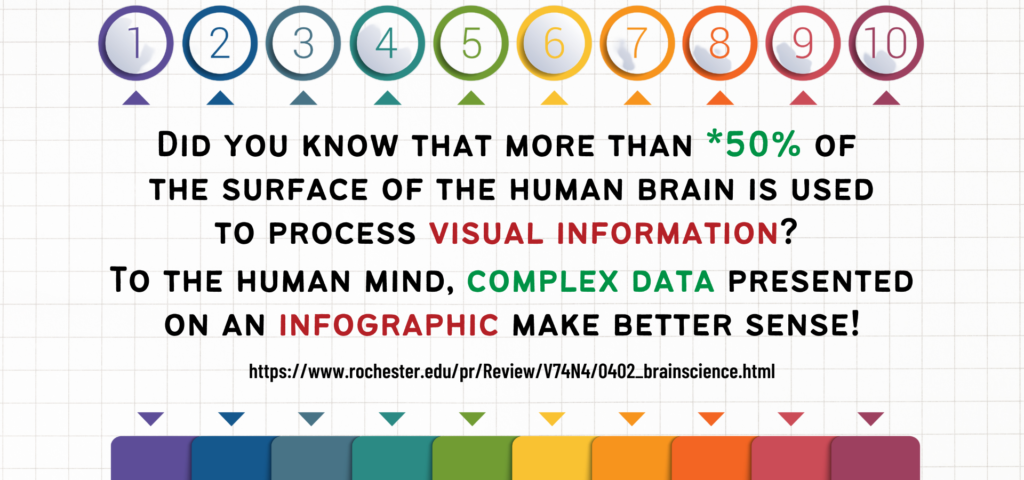Your Practical Guide to Creating An Engaging Infographic
Infographics are content that can catch people’s eyes better than audio or text files. But making them capture and hold the interest of readers isn’t easy. As a content provider, it would be prudent for you to learn to create infographics. It is one important skill you must add to your portfolio. Being versatile and flexible is an important attribute of a talented content provider. Creating an engaging infographic isn’t easy. It requires knowledge, great effort and time to make one. You must learn and follow certain guidelines to create one that will resonate with your audience.
Here are practical techniques you can apply to create an infographic that will capture the eyes and minds of your site’s visitors:
- Set Your Goals
- Work on Your Content
- Create Your Infographics – The Design Phase
- Optimize your Infographic
Set Your Goals

Like most tasks, creating an infographic begins with a plan and a specific goal. This is the phase where you will formulate your concept and strategy.
All infographics are intended to engage with a targeted audience. Your visuals or any content, for that matter, is a useless block of text or image if it doesn’t attract readership. But behind an intent to connect, an infographic has a more specific goal which includes:
- Make people aware of a problem
- Raise brand awareness
- Drive traffic to a particular website
- Encourage people to download a file or app
- Strengthen the relationship between a brand and its customers
An excellent infographic can help you achieve at least two of these goals. Consistent posting will allow you to realize many of these objectives, especially if you mix your visuals with other types of helpful content.
Choose an Interesting Topic
An interesting topic doesn’t revolve only around what’s trending or popular at a particular time. It’s what sparks the interest of your target audience that matters. It can include solutions to their problems or answers to their pressing questions.
To determine these, you must analyze your prospects and learn about their needs. Discover the factors influencing your prospects’ thinking, and know how your information can benefit them. You must be able to sort these out right at the start. It will give you a clear concept of the direction you’re going to take.
Do Your Research
Creating an engaging infographic requires creativity and good knowledge of the topic you want to share. Before starting your project, you have to know as much information about your subject as possible.
Add more to your knowledge by spying on your competition and figuring out a way to use it for the benefit of your readers. Your audience will be happy if you can provide them with fresh data or a new perspective to widen their outlook. You may also browse other infographics or read articles from industry experts. It will help to enrich your knowledge about your subject.
Get visual inspiration from popular sites like Pinterest or Behance.
Work on Your Content

Infographics are visual, but they are intended to convey easy-to-understand information. Information gathering is an important stage of the creation of infographics. Be sure to use only verified facts, as these are the ones that offer value to your readers.
Gather Data from Credible Sources
When you gather data, identify sources that offer credible information. Most of these are presented through:
- Books
- Surveys
- Industry reports
- Presentations from industry or field experts
- Official statistics, etc
Once you’re done with your research, thoroughly review all the information you have gathered. Classify your information and filter it according to importance:
- Must-haves – are key information your readers deserve to know
- Optional – these are less-important information, but they have the potential to enrich your content
- Trash – these are data you don’t want to use because they don’t bring value to your readers.
Create a Title that Catches the Eye and an Outline that Organizes Your Ideas
The title is an essential element of all types of content, including infographics. It has to catch the attention of your targeted readers. Otherwise, your efforts to produce a superb infographic will go down the drain. Consider these tips for creating catchy titles. They can help you attract more readers not only for your infographics but for any content you will create in the future. To come up with a great title, consider these recommendations:
- Know your audience – create your headline with your audience in mind. Inspire them, tempt them or even shock them with your titles. What matters is their ability to stimulate the interest and curiosity of your readers. Use titles that can make them go down to know the rest of your story.
- SEO Optimize (internal linking) – keywords help to get your writing seen by search engines. But since the text is seen as images in infographics, use keywords as part of your headline to make your post more visible.
- Create a knowledge vacuum – A headline that makes readers want to know more is an effective one. Headlines that create a knowledge vacuum are the ones that tickle reader curiosity or intrigue them. It will most probably compel them to read the rest of your story. Ex.: “You’ll Never Know What Can Make You Happy Until You Read This”
- Solve a Problem – A headline that offers a solution to a problem or a bit of educational advice will compel concerned readers to read on. Take this article’s headline as an example. You’re reading it because you want to learn to create engaging infographics!
- Use Technology – Use a headline analyzer to help you determine a title with a high probability of engaging and delivering a strong impression to an audience.
A headline serves as the show window of your story. Make it as engaging as possible, but support it with an equally engaging story.
To create a content outline, build one based on the importance of the information promised by your headline. Be sure to arrange the key elements of your content, such as data, charts and paragraphs, in a logical flow.
Here are some popular structures applied in infographics:
- Story – it refers to the typical presentation, which is done through the introduction-body-conclusion approach.
- Timeline – As its name suggests, it is a chronological presentation of events according to the time at which things happened.
- Numeral or Alphabetical Order – It’s a way of presenting information with equal significance.
- Pros and Cons – A comparison of at least two subjects. It is often presented as two or more vertical sections that show elements that make the subjects different from one another.
Create Your Infographics – The Design Phase

This is undoubtedly the most exciting yet challenging part of an infographics project. Headlines capture the reader’s attention, but the infographic’s design and body sell. It’s actually what makes your reader stay.
Consider these tips to keep you on the right track while creating your infographics:
Pick the Right Tools (and Resources!)
Use your level of expertise and budget to determine the type of graphics software to use. With the myriad of tools you can utilize to create engaging infographics, you’ll never run out of options!
- Photoshop
- Illustrator
- Sketch
- Affinity Designer
- InDesign
- Canva
- Visme
- Google Charts, etc.
Use an Infographic Template – An infographic template is a pre-made design ready to accommodate your content. It is a quicker way to create an infographic than having to design it yourself. Using an infographic template is less costly than hiring a graphic designer. Be sure to choose a template that can communicate your message effectively. There are lots of websites that offer free infographic templates. Take advantage of these sites to save time and energy.
Try Premade Infographic Elements – If you know how to use design software, you can create your content using infographic design elements. There are lots of free infographic elements on the web. Use them.
Take Advantage of the Features of Online Infographic Builders – The web hosts a lot of online infographic builders for users to take advantage of. They’re quite easy to learn and don’t require professional designing skills. Whatever infographic builder you choose will give you a good chance to produce an outstanding infographic. Their design elements and templates library can help you develop a great design.
Hire a Graphic Designer – If you lack confidence in your skills or don’t have time to create infographics, hiring a graphic designer would be prudent. This could cost you some money, but if you need that infographic to accomplish an urgent goal, you may proceed with the hiring.
Sketch and Wireframe
This would be your first attempt to create a visual interpretation of what’s on your mind. It is the design stage. This is where you’ll prepare the rough draft of your infographic piece.
Get a sheet of paper and sketch how you present your ideas. Use your sketch to determine an effective way to distribute your story throughout the infographic. You may use flashcards as visual aids to help you determine places to put textual information and data.
On the other hand, a wireframe is the framework or skeleton of your infographic. It helps you to determine the look of your design and the right place for each inforgraphic element.
Choose Colors and Fonts
This stage allows you to use your artistic skills to make your infographic pleasing and readable.
When determining colors for your infographic, you need to consider two factors: the meaning and effect of colors and branding.
Color determination is an important element of any infographic. Different colors have different effects on readers. Make your infographics more appealing by choosing colors that relate to your message.
If you intend your infographic to promote brand awareness, you should present your design with colors that are consistent with the brand’s colors.
As far as choosing fonts is concerned, there’s no limit to what you want to use. You don’t have to stick to standard web fonts for your infographic to be more effective. Go ahead if you want to use more than one font to make your design more appealing and expressive.
Use Visual Metaphors and Cues
Grammarly fondly describes metaphors as “poetically calling a thing something else.” A fine example of this would be “I am titanium” which means “I am tough.”
The use of visual metaphors does work to make infographics more effective. They help to convey information better, especially if the subject is complex, boring, or confusing. It also refers to the use of analogies your readers can easily understand.
Visual cues, on the other hand, play an important role in an infographic. You can use them to enable your visitor to follow an infographic’s correct sequence of messages. Simply put, they tell your visitor what actions to undertake or which items to read next.
Lines or arrows best represent visual cues. They are symbols that make an infographic more understandable because they tell viewers where to go.
Finish Your Infographic with a Call To Action
Like other forms of web content, infographics are designed to accomplish a definite goal. You need to include a call-to-action button at the end of each infographic.
If your infographic is primarily intended to garner traffic, what would you like your reader to do after reading it? Of course, to perform your ultimate goal, which could be any one of these:
Visit your website or landing page
- Download a file or app
- Sign up for an event or activity
Here are some tricks for making your call-to-action more noticeable:
- Let it stand amid a white space
- Use big and bold fonts
- Use a color that stands out
Always finish your infographics with a CTA. After all, you’re making that content to accomplish one thing – convert readers into leads or customers.
Optimize your Infographic

If people wouldn’t know that your infographic exists, you’re only wasting your time and energy. Make your infographic serve its purpose. Dedicate some time to make it visible to as many people in your target market as possible.
Proofread and Cite Sources
Quality content is distinguished through perfect grammar, spelling and punctuation. Anything below this is nothing but poor content, even if it holds the greatest information one can ever see on the web.
These proven tips will ensure that you are creating quality and error-free content:
- Use a grammar checker tool to find all grammar mistakes
- Leave your work for several hours and come back later to proofread it. It will give your mind and eyes enough time to rest and refresh. It is easier to spot mistakes with fresh eyes and a well-rested mind.
- Cite all the sources of information you use in your infographic, and don’t forget to include their links. You may cite your sources in the infographic or the page where your infographic is published.
Make Your Infographics Shareable and Discoverable
The more prospects your content reaches, the more people become aware of your brand. It gives you greater opportunities for leads and conversions.
Even if your infographics have the best look and message, you must always remember that they are nothing more than static images in the eyes of search engines. Search engines will always perceive them as readable or expertly presented images.
To make your infographics visible online, you must optimize the image itself. Do this by adding alt tags and descriptions to the images and presenting your story in the text below the infographics. It will improve the “discoverability” of the entire content.
Make your infographics shareable. Publish them on image-sharing social media platforms like Pinterest and Behance.
You can also get more views for your infographics by sharing them on these infographic websites:
- SubmitVisuals
- OnlyInfographic
- InfographicBee
- CoolInfographics
- InfographicReviews
- InfographicJournal
- NerdGraph
- InfographicPlaza
Learning to create engaging infographics is a process that requires time, patience and focus. You cannot learn all of it overnight. While you may be able to produce infographics with the help of graphic design platforms, it is still better to acquire adequate knowledge through a step-by-step process.

There is no shortcut to learning. Take your time, set your learning goals, focus on the instructions, and practice till it hurts. You’ll reap the fruit of your efforts in no time. The same exact principle applies to creating your own engaging Infographic!

